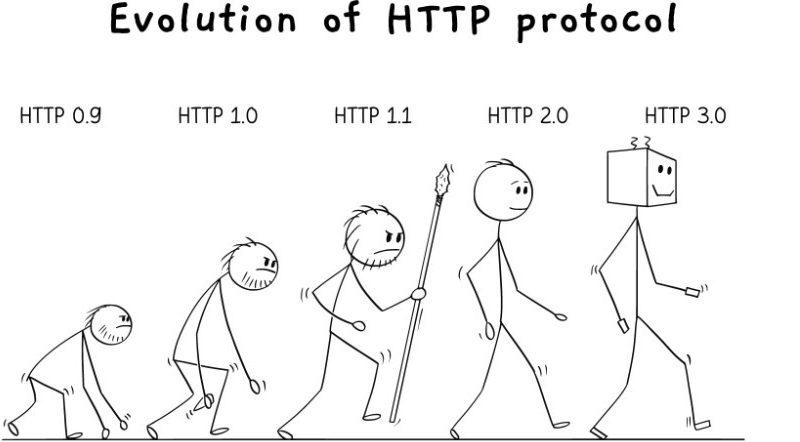The Hypertext Transfer Protocol (HTTP) is the backbone of data communication on the World Wide Web. Over the years, HTTP has undergone significant changes to address the evolving needs of web users and the growing demands of web applications. In this article, we’ll explore the key differences between HTTP/1.1, HTTP/2, and HTTP/3, shedding light on how each version improves upon its predecessor.

1. HTTP/1.1: The Foundation of Modern Web
HTTP/1.1, introduced in 1997, is the first widely adopted version of the HTTP protocol. It laid the groundwork for how web browsers and servers communicate and still forms the basis of much of the internet today.
Key Features of HTTP/1.1:
- Persistent Connections: Unlike HTTP/1.0, HTTP/1.1 allows the reuse of a single TCP connection for multiple requests/responses, reducing the overhead of establishing new connections.
- Chunked Transfer Encoding: This allows a server to start sending a response before knowing its total size, improving responsiveness.
- Host Header: Supports multiple domains hosted on the same IP address, making it possible for web hosting services to host several websites on a single server.
Limitations of HTTP/1.1:
- Head-of-Line Blocking: Only one request can be in transit at a time over a TCP connection. If a request is delayed, all subsequent requests have to wait, leading to inefficiencies.
- Lack of Prioritization: HTTP/1.1 has no native mechanism to prioritize critical resources like CSS and JavaScript, which are essential for rendering a page.
2. HTTP/2: Speeding Up the Web
HTTP/2, standardized in 2015, was designed to address many of the inefficiencies of HTTP/1.1. It introduces several innovations that significantly enhance performance, especially for modern web applications.
Key Features of HTTP/2:
- Multiplexing: Multiple requests and responses can be sent simultaneously over a single TCP connection. This eliminates the head-of-line blocking issue present in HTTP/1.1.
- Header Compression: HTTP/2 uses HPACK compression to reduce the overhead of sending HTTP headers, which are often repetitive and can add significant weight to each request.
- Stream Prioritization: HTTP/2 allows clients to specify the priority of resources, enabling more important resources to load first.
- Server Push: This feature allows the server to send resources to the client before the client requests them, reducing latency.
Limitations of HTTP/2:
- Complexity: The protocol is more complex than HTTP/1.1, making it harder to debug.
- Still Relies on TCP: Despite the improvements, HTTP/2 is still constrained by the underlying TCP protocol, which can be a bottleneck, especially in lossy network conditions.
3. HTTP/3: The Future of Web Performance
HTTP/3, which is currently being adopted, represents a significant departure from its predecessors. It is built on top of QUIC (Quick UDP Internet Connections), a transport protocol developed by Google, and is designed to overcome the limitations of TCP.
Key Features of HTTP/3:
- Built on QUIC: QUIC uses UDP instead of TCP, allowing for faster connection establishment, better multiplexing, and reduced latency. It includes features like error correction and connection migration (for handling changes in network paths) that are not possible with TCP.
- Reduced Latency: QUIC’s design minimizes the time it takes to establish a secure connection, reducing the time to the first byte and improving overall user experience, especially on mobile networks.
- No Head-of-Line Blocking: Unlike TCP, which suffers from head-of-line blocking even in HTTP/2, QUIC ensures that packet loss on one stream doesn’t affect others, making HTTP/3 more resilient.
Challenges with HTTP/3:
- Adoption: As a new protocol, HTTP/3 is not yet universally supported, meaning many users and applications still rely on HTTP/1.1 or HTTP/2.
- Firewall and Network Issues: Because QUIC uses UDP, it can sometimes be blocked or throttled by network equipment that is optimized for TCP traffic.
4. Conclusion: Choosing the Right Protocol
The evolution from HTTP/1.1 to HTTP/2 and HTTP/3 represents a journey toward faster, more efficient, and more reliable web communication.
- HTTP/1.1 is still widely used due to its simplicity and compatibility.
- HTTP/2 offers significant performance improvements for modern web applications, especially those that require multiple resources to load.
- HTTP/3 is poised to become the standard for the future, providing the best performance yet, particularly in environments with high latency or packet loss.
For most users and developers, the choice of HTTP version is typically managed by the web server and the browser, with automatic negotiation to use the best available protocol. However, understanding these protocols can help in optimizing performance and troubleshooting issues in web applications.
As the internet continues to grow and evolve, so too will the protocols that underpin it, with HTTP/3 representing the latest step forward in creating a faster and more resilient web.
